



WASP-127 b is a gas giant located 520 light-years away. It has extreme equatorial winds and no solid surface, primarily composed of hydrogen and helium. Orbiting its host star in just 4 days, its study provides insights into exoplanet atmospheres and planetary climates, aiding future space surveys.

Disclaimer: Copyright infringement not intended.
Scientists have detected 'supersonic winds' travelling at a speed of 33,000 km per hour on a giant gaseous planet named WASP-127b.
|
Feature |
Description |
|
Type |
Hot Jupiter (Gas Giant Exoplanet) |
|
Location |
Milky Way Galaxy |
|
Distance from Earth |
Approximately 520 light-years |
|
Host Star |
Similar to our Sun |
|
Orbit |
Very close to its host star (~5% of the Earth-Sun distance) |
|
Orbital Period |
Completes one orbit in ~4 days |
|
Tidal Locking |
One side always faces the star (dayside), the other remains dark (night side) |
|
Temperature |
~2,060°F (1,400 K / 1,127°C) |
|
Polar Temperature |
Cooler than the rest of the planet. |
|
Size |
~30% larger in diameter than Jupiter. |
|
Mass |
~16% of Jupiter's mass (one of the least dense planets observed) |
|
Composition |
Mainly hydrogen and helium with traces of carbon monoxide and water. |
|
Surface |
No solid surface; consists of dense atmospheric layers. |
|
Atmospheric Pressure |
Increases with depth into the gaseous layers. |
|
Winds |
Extreme equatorial winds are among the fastest recorded on any planet. |
|
Category |
Details |
|
Definition |
Exoplanets are planets that orbit stars outside our solar system. |
|
First Discovery |
Confirmed in 1992. |
|
Number Discovered |
Over 5,000 exoplanets were identified (as per NASA). |
|
Abundance |
Scientists believe there are more planets than stars, as most stars have at least one planet. |
|
Size & Composition |
Exoplanets vary in size and type: Gas giants (larger than Jupiter), Small and rocky (like Earth). |
|
Temperature Range |
Can be boiling or cold depending on their distance from the host star. |
|
Challenges in Observation |
Hard to see directly due to the bright starlight overpowering them. |
|
Detection Methods |
1. Transit Method - Measures dimming of a star when a planet passes in front of it. |
|
Importance of Study |
Expands knowledge of other solar systems. Helps understand the formation and evolution of planets. Aims to answer whether life exists beyond Earth. |
|
Goldilocks Zone |
The habitable zone where an exoplanet is at the right distance from its star to have liquid water, a key factor for potential life. |
Source:
|
PRACTICE QUESTION Q. Exoplanets have become a significant area of research in recent years. Discuss the methods used to discover exoplanets and their implications for understanding the potential for life beyond Earth. (150 words) |







© 2025 iasgyan. All right reserved